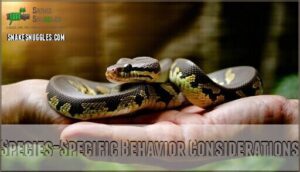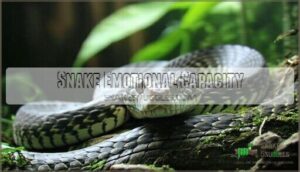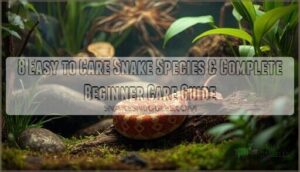This site is supported by our readers. We may earn a commission, at no cost to you, if you purchase through links.

Your snake identifies you primarily through scent using their remarkable vomeronasal organ—the same sensory system that helps them track prey.
They also pick up on your movement patterns, voice vibrations, and daily routines.
While your pet python won’t fetch your slippers or greet you at the door, they can distinguish between familiar and unfamiliar people, which is a form of practical recognition rather than emotional bonding.
Your snake knows you’re the reliable food source and safe handler, which is their version of trust.
The fascinating mechanics behind this recognition reveal surprising nuances in how these seemingly simple creatures navigate their world, showcasing a unique form of recognition.
Table Of Contents
- Key Takeaways
- Snake Recognition Mechanisms
- Do Snakes Recognize Owners
- Snake Perception of Owners
- Bonding With Snakes
- Snake Emotional Capacity
- Frequently Asked Questions (FAQs)
- Do snakes recognize owners?
- Can snakes see us?
- Do snakes recognize humans?
- Do snakes know their keeper?
- Do snakes have a relationship with humans?
- Why do snakes form a bond with their owners?
- How to tell if a snake likes you?
- What does it mean when snakes stare at you?
- Can a snake form a bond?
- How long does snake owner recognition take?
- Conclusion
Key Takeaways
- You’re recognized through scent, not emotion – Your snake identifies you using their vomeronasal organ and Jacobson’s organ, which detect your unique chemical signature rather than forming emotional bonds like mammals do.
- Recognition develops within 2-4 weeks – Through consistent handling and care, your snake will learn to associate your scent with safety and food, showing less defensive behavior around you over time.
- It’s practical trust, not affection – Your snake views you as a reliable food source and safe handler rather than a beloved companion, building familiarity based on survival needs rather than emotional attachment.
- Limited visual and auditory recognition – Unlike dogs or cats, snakes can’t recognize faces or voices due to poor eyesight and hearing, relying primarily on chemical cues and ground vibrations to identify familiar people.
Snake Recognition Mechanisms
Your snake’s recognition abilities rely on sophisticated sensory systems that work differently from mammals.
These reptiles use specialized organs like the vomeronasal system and Jacobson’s organ to detect chemical signatures, vibrations, and environmental cues that help them identify familiar people and situations.
Vomeronasal Organ Function
Your snake’s vomeronasal organ functions like a sophisticated chemical laboratory.
Your snake’s tongue acts as a chemical detective, constantly sampling the world around them.
This paired structure at the nasal cavity base contains specialized receptor neurons that detect non-volatile chemical signals and pheromones.
When your snake flicks its tongue, it collects airborne molecules and delivers them to this organ through vomeronasal ducts.
The organ’s sensory epithelium processes these chemical scents, enabling precise scent detection and recognition of familiar human odors.
The process relies on complex snake recognition mechanisms to identify and respond to the owner’s presence, using complex mechanisms and sophisticated detection.
Jacobson’s Organ Role
Inside your snake’s mouth, the Jacobson’s organ works like a sophisticated chemical analyzer.
This specialized olfactory sense processes scent molecules collected by your snake’s forked tongue, enabling precise scent detection of owners.
Through vomeronasal organ function, snakes decode chemical signals and chemical scent patterns, creating detailed scent recognition maps that help distinguish familiar humans from strangers, using this sense to recognize familiar humans.
Chemical Cue Detection
Through sophisticated scent analysis, your snake’s vomeronasal function processes an incredible array of chemical signals from your skin.
These pheromones carry unique information about your identity, emotional state, and recent activities.
Your snake’s Jacobson’s organ acts like a chemical fingerprint reader, distinguishing your specific scent from others.
This olfactory processing enables precise pheromone detection, helping your snake recognize you through chemical cues that remain consistent over time.
Ground Vibrations Sensing
Your snake’s belly acts like a natural seismograph, picking up ground waves through specialized receptors.
These vibrational cues travel through solid surfaces, alerting your pet to approaching footsteps or nearby movement. This seismic sense works alongside their Jacobson’s organ for thorough sensory perception and snake recognition.
- Floor vibrations – Your snake detects footsteps through floorboards, identifying familiar walking patterns
- Surface tremors – Tank vibrations from handling or nearby activity register as recognizable signals
- Movement detection – Ground waves help distinguish between different people’s gaits and approach styles
- Threat assessment – Vibration detection triggers defensive responses to unfamiliar or sudden movements
Do Snakes Recognize Owners
Your relationship with your snake isn’t one-sided—they can recognize you, though not like a dog would. Snake recognition happens through scent detection rather than visual memory. Your pet snake builds owner trust through repeated exposure to your unique chemical signature.
Reptile intelligence allows snakes to distinguish between familiar and unfamiliar people. This animal recognition creates a foundation for pet bonding, though it’s more about tolerance than affection. Your snake’s brain processes your scent as "safe" rather than forming emotional attachments.
| Recognition Factor | How It Works |
|---|---|
| Scent Memory | Chemical signatures stored for weeks |
| Behavioral Response | Calmer handling with familiar people |
| Time Frame | Recognition develops after 2-3 weeks |
| Individual Variation | Some snakes show stronger preferences |
Snake memory retains scent information effectively, making owner recognition possible. The snake owner relationship develops through consistent care, creating predictable responses. While recognizing owners occurs through chemical cues, snake bonding remains limited compared to mammals.
Snake Perception of Owners
Your snake’s perception of you relies heavily on scent recognition through specialized organs rather than sight or sound.
While they can’t see or hear you clearly like a dog would, snakes develop familiarity with your unique chemical signature over time, which is based on familiarity.
Scent Recognition Importance
Your snake’s nose is like a chemical detective, constantly analyzing the air around them. Through scent analysis and chemical cues, their sophisticated olfactory systems excel at smell detection and pheromone recognition.
The Jacobson’s organ processes these scent cues, creating what researchers call "snake recognition definition" through scent familiarity.
- Snake scent detection happens when chemical particles land on their forked tongue and transfer to specialized receptors
- Laboratory studies show 87% stress reduction when snakes encounter familiar handler scents versus strangers
- Scent imprinting occurs within weeks, with chemical memory lasting several weeks in controlled tests
Visual and Auditory Limitations
Unlike most pets, your snake’s visual acuity and auditory processing create significant sensory deficits.
Snake sight remains limited – they can’t recognize faces or distinguish between people visually.
These visual barriers mean identification relies heavily on other senses.
Similarly, snake hearing faces auditory restrictions, making voice recognition unlikely.
While your snake’s memory connects familiar scents through their Jacobsens organ, poor hearing and limited vision prevent the visual or audio recognition you’d expect from traditional pets, due to significant visual barriers.
Olfactory Gland Function
Your snake’s olfactory system works like a sophisticated chemical laboratory.
The Jacobson’s organ processes scent detection through specialized receptors that analyze pheromones and chemical signals from your skin, clothes, and environment.
This snake scent analysis enables remarkable smell recognition – your pet can differentiate between family members’ unique chemical signatures.
These olfactory capabilities make scent differentiation possible, allowing snake senses to identify you consistently.
Familiarity and Trust Building
Building your snake’s trust happens gradually through consistent interactions.
Each handling session becomes a building block in your owner snake relationship, as your pet learns to associate your scent and presence with safety rather than threat.
- Regular handling sessions help establish snake habituation to human contact
- Consistent feeding schedules strengthen snake owner recognition patterns
- Proper handling techniques reduce stress and build snake trust over time
- Environmental enrichment creates positive associations between you and comfort
Snake familiarity develops when you become a predictable part of their world, transforming initial wariness into acceptance through patience and routine care.
Understanding snake recognition abilities is essential for building a strong bond with your pet snake.
Bonding With Snakes
While you can’t truly "bond" with a snake like you’d a dog or cat, you can build a relationship based on familiarity and trust through consistent, patient interactions.
Most snakes will learn to recognize your scent and handling patterns, becoming more relaxed around you over time rather than forming an emotional attachment.
Time and Patience Importance
Developing trust with your snake isn’t like flipping a switch—it’s more like watching grass grow.
Your snake needs weeks or months to recognize your scent and associate you with safety.
Rushing the snake bonding process with aggressive Handling Techniques backfires spectacularly.
Instead, use a Slow Approach with brief, Gentle Interaction sessions.
This Consistent Care builds the foundation for snake trust and familiarity over time.
Proper reptile care products, including reptile care, are essential for creating a safe environment.
Consistency and Repetition Benefits
Establishing handling routines creates predictable patterns that help your snake develop owner familiarity through repetitive interactions.
These consistent experiences form the foundation of trust building and habit formation in your pet’s daily life. Regular, gentle contact teaches your snake that you’re safe, reducing stress responses over time.
Through owner recognition based on scent and touch patterns, your snake learns to associate your presence with security rather than threat, making the snake bonding process smoother and more effective.
Proper reptile care products, including reptile care, are essential for maintaining a healthy environment that supports this bonding process.
Enrichment and Stimulation Needs
Environmental Stimulation keeps your snake mentally engaged and prevents stress-related behaviors.
Providing varied textures, hiding spots, and climbing opportunities mimics their natural habitat. Sensory Enrichment through different substrates and temperatures encourages exploration, while Habitat Diversity with multiple microclimates supports natural behaviors that strengthen owner recognition.
- Rotating hiding boxes made from different materials (cork bark, plastic caves, ceramic pots) stimulate tactile exploration
- Temperature gradients across the enclosure allow thermoregulation choices and encourage movement patterns
- Textured substrates like aspen shavings mixed with cypress mulch provide digging opportunities for burrowing species
- Climbing branches at various heights activate natural behaviors and muscle development in arboreal species
- Scent trails from prey items or shed skin create cognitive challenges that engage their vomeronasal organ
Understanding snake behavior and enrichment ideas is essential for creating an engaging environment that promotes their physical and mental well-being.
Species-Specific Behavior Considerations
Your snake’s breed dramatically affects how they’ll respond to you.
Ball pythons naturally show docile temperaments, making them easier to handle and bond with, while species like carpet pythons display more defensive behaviors.
Arboreal species require different environmental enrichment than terrestrial ones.
Understanding these species-specific behaviors helps you tailor your handling techniques and recognize authentic signs of comfort versus stress in your particular snake.
Proper Ball python care tips are essential for building trust with your pet, and recognizing authentic signs of comfort is crucial for a healthy relationship.
Snake Emotional Capacity
Understanding snake emotions requires looking beyond human concepts of feelings.
While snakes possess basic emotions tied to survival like fear and aggression, they lack the complex emotional systems found in mammals and operate primarily on instinct rather than sentiment.
Primitive Emotions Existence
Your snake’s emotional world operates on a basic level, driven by fundamental responses rather than complex feelings.
Your snake operates on survival mode, not sentimental attachment like your dog or cat.
Unlike mammals, snakes possess primitive emotions tied directly to survival needs, with their fear response serving as their primary emotional compass.
Here’s what drives your snake’s reptile feelings:
- Fear and stress – Your snake’s most developed emotion, triggering defensive behaviors when threatened
- Pleasure from warmth – Simple contentment when basking or finding ideal temperatures
- Aggression response – Raw reaction to perceived threats or competition for resources
- Basic comfort – Relaxation when safe, fed, and in suitable conditions
While your snake lacks the emotional intelligence of dogs or cats, these primitive emotions still influence snake recognition patterns.
Your pet’s brain processes familiar scents and vibrations through this simplified emotional framework, creating associations between your presence and safety.
This basic emotional system explains why snake owner bonding feels different – it’s built on trust and familiarity rather than affection.
Survival Instincts Priority
Everything about your snake boils down to staying alive.
When push comes to shove, Food Priority and Predator Avoidance trump any owner relationship you might think exists.
Understanding defensive behavior mechanisms is essential in interacting with snakes safely.
| Survival Priority | Behavioral Response | Override Factor |
|---|---|---|
| Food acquisition | Strikes at movement | Hunger supersedes familiarity |
| Threat detection | Defensive coiling | Fear overrides recognition |
| Escape routes | Rapid retreat | Safety before social bonds |
| Temperature regulation | Hiding behavior | Comfort needs dominate |
| Territorial defense | Aggressive posturing | Space protection instinct |
Your snake’s survival instincts operate like a biological computer program that can’t be updated through friendship.
Anthropomorphism Risks
You might think your snake "loves" you when it seems calm during handling, but that’s likely Human Error through Emotional Projection.
This anthropomorphism leads to Misinterpretation of basic tolerance as affection. Attribution Bias makes owners read complex emotions into simple behavioral responses, creating unrealistic expectations about snake intelligence and emotional capacity.
Common Overpersonification mistakes include:
- Interpreting exploration as seeking attention
- Assuming stillness means contentment
- Reading curiosity as emotional bonding
- Believing defensive behavior shows personal rejection
Understanding animal recognition versus emotional attachment helps maintain realistic expectations about your snake owner snake relationship, and prevents Misinterpretation of basic behaviors, allowing for a clearer understanding of emotional capacity and snake intelligence.
Emotional Complexity Debate
While scientists acknowledge that snakes possess basic emotions like fear and aggression, most herpetological experts agree they lack complex emotional systems seen in mammals.
Research on reptile intelligence and animal sentience reveals limited cognitive ability for advanced feelings.
However, some researchers argue for an emotional complexity spectrum in snake recognition and snakeowner relationships, though consensus restricts this to survival-based responses rather than true animal emotions.
Frequently Asked Questions (FAQs)
Do snakes recognize owners?
Like a fingerprint scanner reading your unique scent signature, you’ll find that snakes primarily recognize you through their vomeronasal organ.
They detect your specific chemical cocktail—pheromones, sweat, and even your soap—building familiarity over time through consistent handling and care.
Can snakes see us?
Yes, snakes can see you, but their vision isn’t sharp like yours.
Most snakes have limited visual acuity and rely more on detecting movement and heat signatures than recognizing faces or detailed features.
Do snakes recognize humans?
Snakes can distinguish between familiar and unfamiliar humans through scent recognition using their Jacobson’s organ.
They’ll associate your unique chemical signature with safety and food, showing less defensive behavior around you over time.
Do snakes know their keeper?
Like ancient guardians recognizing trusted visitors, your snake knows you through scent and vibrations.
They’ll sense your unique chemical signature and movement patterns, becoming more relaxed during handling as familiarity builds over time.
Your snake will recognize you and become more comfortable with handling as time passes.
Do snakes have a relationship with humans?
While snakes don’t form emotional bonds like mammals, they can develop familiarity with their keepers through scent recognition and consistent handling.
Creating a practical relationship based on trust rather than affection is the outcome of this familiarity.
Why do snakes form a bond with their owners?
Trust blooms like a garden when you consistently meet your snake’s needs. They recognize you through scent, associating your presence with safety, food, and comfort, building familiarity over time.
How to tell if a snake likes you?
Your snake’s relaxed body language during handling, calm exploration of your hands, and reduced defensive posturing indicate comfort with you.
They’ll move smoothly without tensing, rarely hide when you approach, and show curiosity rather than fear during interactions.
What does it mean when snakes stare at you?
Unlike a predator’s focused hunt, your snake’s steady gaze isn’t threatening—it’s curiosity.
They’re using limited vision and heat detection to assess you, gathering information about their environment and recognizing your familiar presence through scent.
Can a snake form a bond?
Yes, you can form a bond with your snake, but it’s different from bonds with mammals.
Your snake recognizes you through scent and develops trust over time through consistent handling and care.
How long does snake owner recognition take?
Gradual gains grow through consistent contact.
You’ll typically see recognition developing within 2-4 weeks of regular handling.
Your snake’s scent-based memory strengthens with each interaction, creating familiarity that reduces defensive behaviors and builds trust.
Conclusion
Remarkably, your snake’s ability to recognize you mirrors how they’ve survived for millions of years—through precise sensory detection rather than emotional attachment.
While snakes do recognize their owners through scent, vibrations, and routine patterns, this recognition serves purely practical purposes.
Your pet snake views you as a reliable food source and safe handler, not a beloved companion, which helps you appreciate your snake’s unique behavioral patterns.
Understanding this fundamental difference helps you appreciate your snake’s unique behavioral patterns while maintaining realistic expectations about your relationship with these fascinating reptiles.












